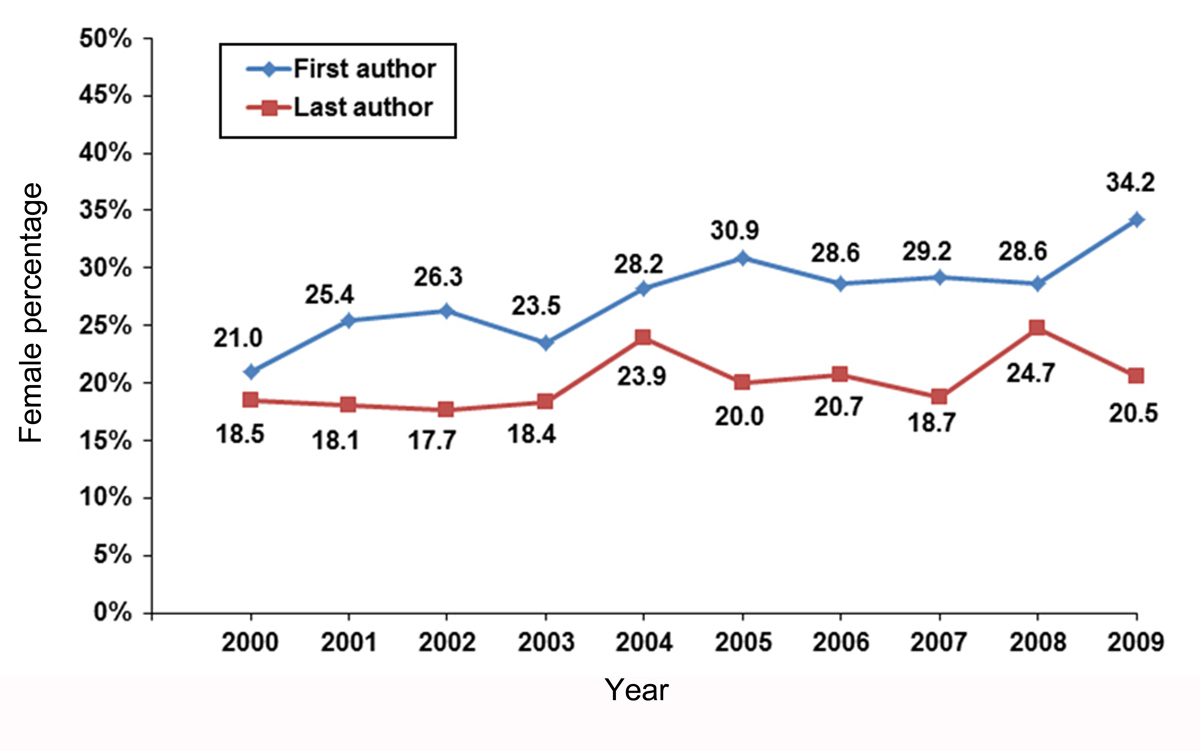Trends in female representation in published ophthalmology literature, 2000-2009
Main Article Content
Abstract
Purpose
To examine trends in female first and last authors in clinical ophthalmology literature published from January 2000 to December 2009.
Methods
A total of 3760 articles in American Journal of Ophthalmology (AJO), 2347 articles in Archives of Ophthalmology (Archives), and 3838 articles in Ophthalmology spanning 10 years of published ophthalmology peer-reviewed literature were examined. All original research articles and brief reports indexed online were included. Author gender was determined by an exhaustive Internet search. Articles were excluded if the sex of the author could not be determined or was not applicable (for example, articles by a study group rather than an individual author).
Results
Gender information was identified in 86.8% of articles for first authors and 86% for last authors. The number of female first authors (P < 0.0001) and last authors (P = 0.005) increased significantly in the study period in all journals examined, with a significant association between the sex of the first and last authors (OR = 2.19; 95% CI, 1.96-2.46; P < 0.0001), when examining all articles. Female representation increased for last authors significantly only in Ophthalmology. There was a significant correlation between gender of the first author and total number of authors that was not observed with last-author sex.
Conclusion
Female first authorship has increased from 2000 to 2009 and is correlated with the gender of the last author; however, there were fewer female last authors compared to female first authors in the same period.
Downloads
Article Details

This work is licensed under a Creative Commons Attribution-NonCommercial-NoDerivatives 4.0 International License.
References
Leadley J, Sloane RA. Women in U.S. Academic Medicine: Statistics and Benchmarking Report 2009-2010. Association of American Medical Colleges; 2011:17.
Jagsi R, Guancial EA, Worobey CC, et al. The “gender gap†in authorship of academic medical literature—a 35-year perspective. N Engl J Med 2006;355:281-7. DOI: https://doi.org/10.1056/NEJMsa053910
Li SF, Latib N, Kwong A, Zinzuwadia S, Cowan E. Gender trends in emergency medicine publications. Academic emergency medicine : official journal of the Society for Acad Emerg Med 2007;14:1194-6. DOI: https://doi.org/10.1197/j.aem.2007.08.009
Bergeron JL, Wilken R, Miller ME, Shapiro NL, Bhattacharyya N. Measurable progress in female authorship in otolaryngology. Otolaryngol Head Neck Surg 2012;147:40-3. DOI: https://doi.org/10.1177/0194599812438171
Bhattacharyya N, Shapiro NL. Increased female authorship in otolaryngology over the past three decades. Laryngoscope. 2000;110:358–61. DOI: https://doi.org/10.1097/00005537-200003000-00005
Okike K, Liu B, Lin YB, et al. The orthopedic gender gap: trends in authorship and editorial board representation over the past 4 decades. Am J Orthop (Belle Mead NJ) 2012;41:304-10.
Weiss D a, Kovshilovskaya B, Breyer BN. Gender trends of urology manuscript authors in the United States: a 35-year progression. J Urol 2012;187:253-8. DOI: https://doi.org/10.1016/j.juro.2011.09.029
Sidhu R, Rajashekhar P, Lavin VL, et al. The gender imbalance in academic medicine: a study of female authorship in the United Kingdom. J R Soc Med 2009;102:337-42. DOI: https://doi.org/10.1258/jrsm.2009.080378
Feramisco JD, Leitenberger JJ, Redfern SI, Bian A, Xie X-J, Resneck JS. A gender gap in the dermatology literature? Cross-sectional analysis of manuscript authorship trends in dermatology journals during 3 decades. J Am Acad Dermatol 2009;60:63-9. DOI: https://doi.org/10.1016/j.jaad.2008.06.044
Mansour A, Shields C, Maalouf F, et al. Five-decade profile of women in leadership positions at ophthalmic publications. Arch Ophthalmol 2012;130:1441-6. DOI: https://doi.org/10.1001/archophthalmol.2012.2300
Dickersin K, Fredman L, Flegal KM, Scott J, Crawley B. Female editorship is an important indicator of gender imbalance. J R Soc Med 2010;103:5. DOI: https://doi.org/10.1258/jrsm.2009.09k071
Dickersin K, Fredman L, Flegal KM, Scott JD, Crawley B. Is there a sex bias in choosing editors? Epidemiology journals as an example. JAMA. 1998;280:260-4. DOI: https://doi.org/10.1001/jama.280.3.260
Hamel MB, Ingelfinger JR, Phimister E, Solomon CG. Women in academic medicine—progress and challenges. N Engl J Med 2006;355:310-32. DOI: https://doi.org/10.1056/NEJMe068143
Nonnemaker, L Women physicians in academic medicine: new insights from cohort studies. N Engl J Med;342:399-405. DOI: https://doi.org/10.1056/NEJM200002103420606
Pololi LH, Civian JT, Brennan RT, Dottolo AL, Krupat E. Experiencing the culture of academic medicine: gender matters, a national study. J Gen Intern Med 2013;28:201-7. DOI: https://doi.org/10.1007/s11606-012-2207-1
Wright AL, Schwindt LA, Bassford TL, et al. Gender differences in academic advancement: patterns, causes, and potential solutions in one US College of Medicine. Acad Med 2003;78:500-8. DOI: https://doi.org/10.1097/00001888-200305000-00015
Housri N, Cheung MC, Koniaris LG, Zimmers TA.. Scientific impact of women in academic surgery. J Surg Res 2008;148:13-16. DOI: https://doi.org/10.1016/j.jss.2008.02.015
Bickel J. Women in medical education. N Engl J Med 1988;319:1579-84. DOI: https://doi.org/10.1056/NEJM198812153192405
Yedidia MJ, Bickel J. Why Aren’t There More Women Leaders in Academic Medicine? The views of clinical department chairs. Acad Med 2001;76:453-65. DOI: https://doi.org/10.1097/00001888-200105000-00017
Zhuge Y, Kaufman J, Simeone DM, Chen H, Velazquez OC. Is there still a glass ceiling for women in academic surgery? Ann Surg 2011;253:637-43. DOI: https://doi.org/10.1097/SLA.0b013e3182111120




